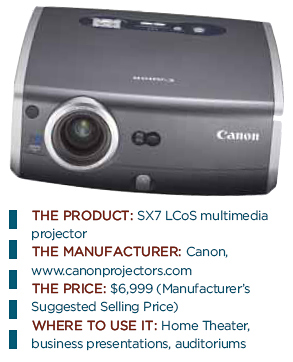Reviewed by Chuck Gloman
Canon has does it again with the REALiS SX7, which is the latest member of Canon's REALiS line. It features the company's AISYS (Aspectual Illumination System)-enhanced LCOS (Liquid Crystal on Silicon) display technology and lists for a hefty $6,999, but as the old adage goes, you get what you pay for.
Canon's AISYS system, featured in its entire REALiS line (SX7, SX6, SX60, and X700), optimizes the light from the projection lamp and delivers brighter than bright performance; 4000 lumens, in the case of the SX7. They also boast that the SX7 is the brightest projector in its weight class (light middleweight).
Other features include an impressive lens (1.7x powered zoom), which means the projector does not have to be in the next county to get a large image. The size of your picture is determined by three factors: the lens (the distance the projector needs to be from the screen), the resolution (how sharp and clear the image), and the lumens (how bright the image is).
I tested the SX7 in several different arenas to check its versatility. I had three unique set-up environments: a home theater, a small presentation group in a conference room (about 20 people), and a large auditorium (seating 600). This, in my opinion, would be the natural range that this projector may be used.
In my home theater, the SX7 was placed ten feet from the screen and easily filled my 74-inch (diagonal) screen with the zoom lens. For inputs, there are several choices: an analog PC input that enables the supplied mini D-sub 15- pin cable; a second analog PC-2 input for a VGA cable; a digital PC connection that requires an optional DVI digital cable; a VGA monitor output; a S-Video connection; a RCA video input; RS-232C; and a USB input to be used when you want the projector's remote control to function as a mouse. There are also three stereo audio ins, and a stereo audio out.
The SX7 will also accept component video in by supplying a three-color connector RCA-to-VGA cable. If using high definition, you can purchase an HDMI-to-DVI cable to view the source. Rather than using BNC connections, most users will have RCA cables, so basically you can get any source to the projector. The SX7 is simple to set up and operate. Pressing the Auto Set button will activate this, and it is accurate. The "image mode" is a little more complicated than it needs to be, with too many picture options. You must look at each one to determine what best suits your needs.
There are dozens of settings to customize your image. This portion is subjective, but again you are offered a lot of choices. When I displayed a VHS or DVD-R image using the RCA cable, the projected image was disappointing. The inherent flaws in this older technology (the VHS and DVD) were too visible. When watching a live TV signal through digital cable, the picture looked great - extremely sharp.
When I watched the same sources (VHS and DVD-R) using the S-Video connector, the image was vastly improved. Using progressive scan technology with component cable is superior, and provides the best analog picture the SX7 allows. Using true HD at home brings tears to your eyes because the picture is that brilliant.
The presentation to a group of 20 in a conference room allowed me to connect my Sony VAIO laptop to the SX7. With a 150-inch screen and the projector about 15 feet away on the conference table, I connected my laptop VGA cable, and the results were striking. This projector is a winner in the "conference mode." Still photos looked even more brilliant than on my laptop screen. Minute details were evident in the images, and this projector is fantastic at displaying finely printed text.
My final test with this projector was in a large theater with 600 invited guests. The screen measured 10-feet 6-inches high by 14-feet wide. The SX7 was mounted under the theater's catwalk at a distance of about 30 feet from the screen. With 4000 lumens, the darkened auditorium provided a digital movie theater-like environment with the projector's lens zoomed out about halfway. Our school's 2000-lumen projectors are pushed to their limits in this setting; the REALiS SX7 was not even breaking a sweat. This is where the projector belongs!
This projector excels in every setting, with the small group presentation being its most comfortable home. If you are in the market for a versatile new projector with some punch, I believe Canon's REALiS SX7 would be an excellent choice.
THE SPECIFICATIONS
LIGHT ENGINE: 0.7-inch
Reflective LCD Panel (LCOS) x 3
NATIVE RESOLUTION: SXGA+
SUPPORTED RESOLUTIONS:
SXGA, WXGA, XGA, SVGA, VGA,
HDTV, DTV, (compressed) UXGA
VIDEO COMPATIBILITY:
NTSC/PAL/SECAM/NTSC4.43/
PAL-M/PAL-N
INPUTS: S-Video, Composite,
Component, VGA, DVI-I, Stereo
Audio x3, USB, Component
5BNC (with optional accessory),
RS-232 (for control systems)
BRIGHTNESS: 4000 ANSI
lumens
PROJECTION LENS: f=21.7 -
35.8mm, F1.85 - 2.5, 1.7x Zoom
SCREEN SIZE: 40 to 300 inches
CONTRAST RATIO: 1000:1
LAMP: 275W NSH (AC)
POWER CONSUMPTION: 360W
(Normal) / 290W (Silent)
WEIGHT: 10.6 lbs (4.8kg)
DIMENSIONS: (W x H x D): 10.5
x 13.2 x 4.5 inches
Chuck Gloman is an awarding- winning producer/ director of photography with over 800 commercials to his credit, and is program director of the TV/Film Department as well as a member of the faculty of DeSales University. He may be reachedchuck.gloman@desales.edu.











